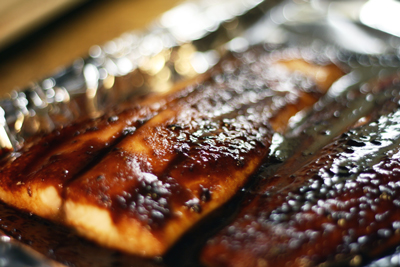Our planet is running out of seafood, and it’s my fault. (It’s probably your fault, too.) There are a bunch of fish—sadly, most of humanity’s favorites—that are being overfished, global-warmed, and polluted basically out of existence.
The most serious of these is bluefin tuna, AKA toro, the kind of tuna that goes into high-end sushi all around the world. The delicious species is on the razor’s edge of extinction: There are only a few thousand left by some estimates. If you care about the planet at all, you should probably not eat any of it again.
And that’s not the only fish to steer clear of: For various reasons, Atlantic salmon, imported farmed shrimp, and freshwater eel (AKA unagi, my favorite sushi-roll ingredient) are all rated as “avoid” by the Monterey Bay Aquarium’s Seafood Watch guide.
But it’s not all bad. Wild-caught Alaskan salmon is an extremely well-managed fish, and you can eat as much of it as you’d like without worrying about the environment (your wallet, on the other hand, might take a beating). And shrimp from the US (like the Gulf of Mexico), whether it’s farmed or wild-caught, is fine as well. There are even several kinds of tuna that are safe to eat—it just depends on how and where they were caught.
The key is doing your research. Seafood Watch has a wealth of information (and even an iPhone app), which I use all the time and recommend highly. You’ll also have to ask questions at your supermarket: Where was this caught? Was it caught in a net or via longline? What kind of feed does the farm use? Yeah, it’s a pain, but the way things are going, you kinda have to.
And unfortunately, the way things are going, many of the fish you like today will be harder and harder to find in the coming years. I’ve found that many of the most sustainable fish deserve a reappraisal by American palates. These are oilier, “fishier” fish that lots of people consider icky—like sardines.
Lately, I’ve gotten hooked on another one of these: mackerel. The small, dark-colored fish is great on the grill, has awesome flavor, and it’s cheap! Plus, almost all of it sold in supermarkets is a Seafood Watch “best choice” (Atlantic mackerel caught in the US, as opposed to Canada, is merely a “good alternative.”
The key to mackerel is high-heat, quick cooking. All that oil in it is flavor, but the fillets are thin, which means they’re prone to overcooking. And as they have a strong flavor, they’re best partnered with other strong tastes. I love mackerel with miso, Japanese fermented soybean paste that has loads of salty, umami flavor with a little bit of blue-cheese funk. (You might be familiar with it in the rich soup that’s often served at sushi joints.)
Miso comes in two varieties, red and white. Really either one works for this recipe, but I happen to have white miso in my fridge. You just thin it out a little bit with soy sauce and rice vinegar, plus some honey for sweetness, then spread on the fish and broil. Since it cooks all the way through from the top down, the miso-coated side of the fish gets nice and crisp and highly flavored, leaving moist and tender flesh underneath.
Paired with rice and maybe some stir-fried vegetables, this recipe makes a nice lunch for two or dinner for one. It’s easy as hell, and you can even minimize the dishes—I’ll cook this in my toaster oven and eat it right off the broiler tray!
Miso-Broiled Mackerel
1/4 cup white miso
1 tsp. soy sauce
1 tbsp. rice vinegar
1 tbsp. honey
2 mackerel fillets (about 8 oz.)
Preheat the broiler. Stir together the miso, soy sauce, rice vinegar and honey in a small bowl. Place the mackerel skin-side-down on a broiler pan lined with aluminum foil and spread the miso mixture evenly on top. Broil until cooked through completely, about 5-7 minutes. (If the miso mixture begins to burn before the fish is cooked, move the pan further from the heat.)

@messyepicure And produce differently.
That sounds delicious–it looks like eel. Does it taste like eel? If there are so few bluefin tuna, how do they even find them? I saw that Whole Foods is changing its fish policies this week. Last thing, do you know if any fishes are both sustainable and lowest in mercury? Maybe tilapia? (WF article: http://www.businessweek.com/ap/2012-03/D9TR39180.htm)
Mackerel tastes nothing like eel—although I’m basing that on the fact that eel pretty much tastes like that sweet sauce they put on it at sushi joints. It’s got a little bit of “fishy” flavor like sardines or anchovies, but not as much. Kinda similar to trout.
As for bluefin tuna, they find them because they can sell them for many thousands of dollars. There are actually a few tuna “ranching” operations, where they net off a huge area of ocean and fatten up fish in it. This is unfortunately not a sustainable alternative either, as the tuna will eat just about all other living things in the ranch area.
And yes, mercury is an issue with all oily fish, including mackerel, though it’s a comparatively minor one. Depending on how it’s farmed, tilapia can indeed be very sustainable, and it doesn’t have the same mercury issue. There are actually some very cool systems where you can grow crops and raise tilapia and the two sustain each other, kind of like this project: http://gardenpool.org/